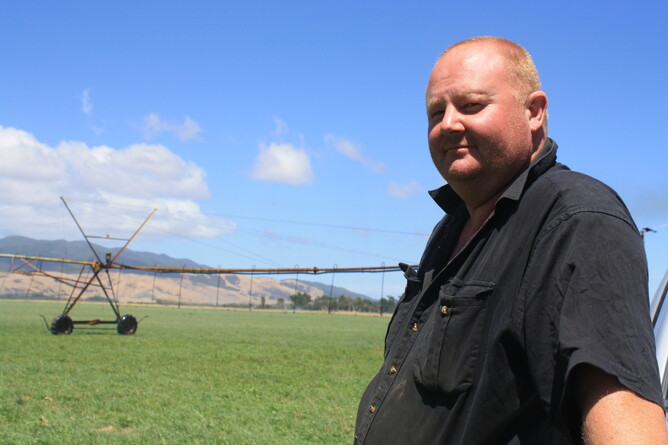It’s a classic story of Kiwi innovation and invention.
One summer’s evening in late 2004, two Massey University engineering graduates, Stu Bradbury and George Ricketts, were sitting around, chewing the fat.
They were staying on the South Wairarapa farm of Brian and Jo Bosch, living on site while they worked a summer job assembling irrigators in the area. Over a cuppa, Stu, George and Brian talked about irrigation, and some of the challenges on the Bosch’s farm – the existing pivot irrigation system was causing problems.
“Where the pivot went over the races was wet and mucky, and when the cows walked along it to get to the cow shed it damaged the race,” says Brian. “We were also getting a number of lame cows, who got wet feet and bruising on the muddy race.”
Blanket irrigation was the problem, says Brian. There had to be a way of irrigating parts of the farm that needed it, but keeping vulnerable areas such as the race dry.
Stu and George, both bright minds with mechanical engineering backgrounds, began thinking about how to solve the problem. At the time there was nothing on the market that could deliver precision irrigation, managing the water flow in targeted and controlled quantities, to specific parts of a paddock or farm depending on topography and soil type.
“When we went out on the farm we saw wet areas where crops weren’t growing, and dry areas where there wasn’t much water. So there was an obvious need to have a system to specify where you needed water and how much,” says Stu.
With his Kiwi DIY number eight wire mentality, it wasn’t long before George came up with a solution, using technology to solve the problem.
In 2006 and 2007 they began developing the programming and prototype that would become the Precision VRI.
VRI stands for variable rate irrigation, ensuring exactly the right amount of water or nutrients are delivered over multiple crops, soil types and terrains. It would involve GPS technology, farm mapping and innovation that would revolutionise the irrigation industry.
The technology involves first making an electromagnetic map of the land, measuring soil conductivity (soil type and the amount of water it holds) and then developing a programmable irrigation system where every nozzle can be individually controlled, allowing customised irrigation within a field.
Farmers could simply drive across their land with an electro-magnetic sensor and a Real-Time Kenematic GPS, accurate to within 2cm, to map their land and use that information to programme the Precision VRI system.
The Bosch farm at Kahutara became the very first farm in the world to install the Precision VRI system, in November 2008. “It’s still going strong today,” says Brian, who is pleased to see its 10-year anniversary roll around.
Brian currently milks 1000 cows on the farm, achieving around 400,000 kilograms of milk solids annually over the 320-hectare milking platform. He says that the Precision VRI helps him farm more productively and ensures he isn’t wasting water – a precious resource.
Brian says that muddy areas around troughs and races are also no longer a problem, and he no longer has the problem with lame cows he once did. Land is more productive, and areas that were previously muddy can now be used for growing grass or crops. Places where tractors and heavy farm vehicles used to get stuck, have been dried out and are traversable.
Brian says irrigation is “vital” to his farm and growing good pasture for his herd, to ensure productivity. “We’re huge fans of the Precision VRI.”
The system enables farmers to control water usage in a sustainable, smart way. It ensures that only the areas that need water, get water, and at the right levels. Individual nodes across the system can be programmed to specific levels, meaning areas of a paddock just metres apart receive different amounts of water.
It also ensures that nutrients applied to grass and crops penetrate at the right levels, and are not washed down into the soil where they are wasted or washed away as run-off water, causing damage to the environment if nutrients enter waterways.
Precision irrigation also helps conserve water, preventing excessive water waste on areas where it is not needed up to 30 per cent across a farm in some cases.
Over the past decade Prevision VRI has enabled New Zealand’s farmers, food producers and agricultural contractors to achieve better results, driving efficiencies and saving money – to the benefit of agribusiness, not only for dairying, but in sheep, beef, horticulture and arable farming.
The system has also been used in Australia and the USA, attracting the attention of agribusiness leader Lindsay Corporation. The global company acquired the Precision VRI in 2011, attracted by the success and potential of the system.
Today George and Stu are still part of the core team behind Precision VRI, working at Lindsay NZ to continue to innovate and develop the system – a Kiwi innovation they want to share with the world.
“We are working on new iterations of the software, and making small improvements,” says Stu. There are further plans to develop mobile technology support, so Precision VRI can suit the needs of modern farmers. “Now, everything needs to be on your phone so that is where our efforts are focused.”
As the pioneer and the world’s longest-serving irrigation system of its kind, Lindsay’s Precision VRI continues to lead the way. There are also plans to market the system internationally, to give farmers around the world the advantages experienced by New Zealand farmers using the system.
To find out more about Lindsay NZ’s Precision VRI system call 0800 438 627 or visit lindsay.com.

